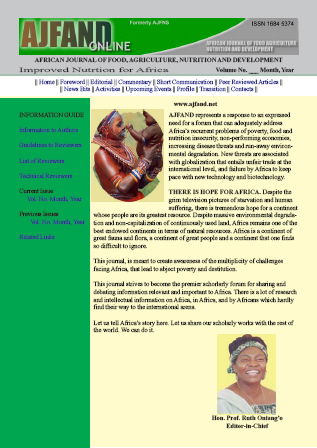
|
African Journal of Food, Agriculture, Nutrition and Development
Rural Outreach Program
ISSN: 1684-5358
EISSN: 1684-5358
Vol. 21, No. 8, 2021, pp. 18501-18517
|
 Bioline Code: nd21086
Bioline Code: nd21086
Full paper language: English
Document type: Research Article
Document available free of charge
|
|
|
African Journal of Food, Agriculture, Nutrition and Development, Vol. 21, No. 8, 2021, pp. 18501-18517
| en |
CHROMATOGRAPHY AND MASS SPECTROSCOPY ANALYSIS OF BIOACTIVE PRINCIPLES FROM VERNONIA AMYGDALINA  LEAF AQUEOUS EXTRACT LEAF AQUEOUS EXTRACT
Adiukwu, PC & Tebogo, MO
Abstract
Application of medicinal plants in managing disease conditions is a practice as old as
mankind. Its use in today’s healthcare has increased astronomically when compared to
any other era. National policies, which integrate herbal products in healthcare systems,
and the increasing presence of herbal clinics have become the order in many countries.
Despite the ease of accessibility and affordability, the use of products from medicinal
plants as phyto-medicines is threatened by the inability to maximize the benefits. This is
due to inadequate qualitative and quantitative data necessary for proper application and
regulation. Vernonia amygdalina, a herb widely used by ethnics in diverse forms of
health management, is one such medicinal plant. This study was designed to determine
referenceable values for the ethno formulation of the herb which is usually prepared as
the aqueous extract of the leaf. Standard techniques and procedures were employed for
this study. Fractionation of the extract was carried out using facilitated column
chromatography. Pure principles of fractionates were separated with gas chromatography
and identified using hyphenated mass spectrometer based on their relative abundance.
The obtained chromatogram and spectra of principles were elucidated by relating data to
the Mass Spectral Database with Automatic Mass Spectra Deconvolution &
Identification System (AMDIS). Preliminary screening of extract indicated the absence
of quinine but presence of alkaloids, tannins and saponins. Aqueous extraction produced
18 % (w/w) yield. The accelerated column chromatography produced a yield in the ratio
of four to six to nine for the chloroform, chloroform/methanol and methanol effluents,
respectively. Data obtained from the AMDIS elucidation showed the presence of eleven
principles, which includes 1, 2, 3, 4-Butanetetrol; 1, 2-Benzenediol; and Caprolactam
among others. Some of the properties and bioactivities of these principles have been
reported in previous literature. Findings suggest that bioactivity common with some of
these principles is consistent with previous literature on the use of the herb, and
demonstrates reasons for the folkloric application.
Keywords
Chromatogram; flash column; extract; hyphenated technique; leaf; medicinal; spectra
|
| |
© Copyright 2021 - African Journal of Food, Agriculture, Nutrition and Development
Alternative site location: http://www.ajfand.net/
|
|
